Chilled Sesame Soba Noodles with Soy-Ginger Dressing
Discover my easy soba noodles recipe with a zesty soy-ginger dressing. Perfect for gluten-free meals and quick soba meal prep. Ready in under 25 minutes!
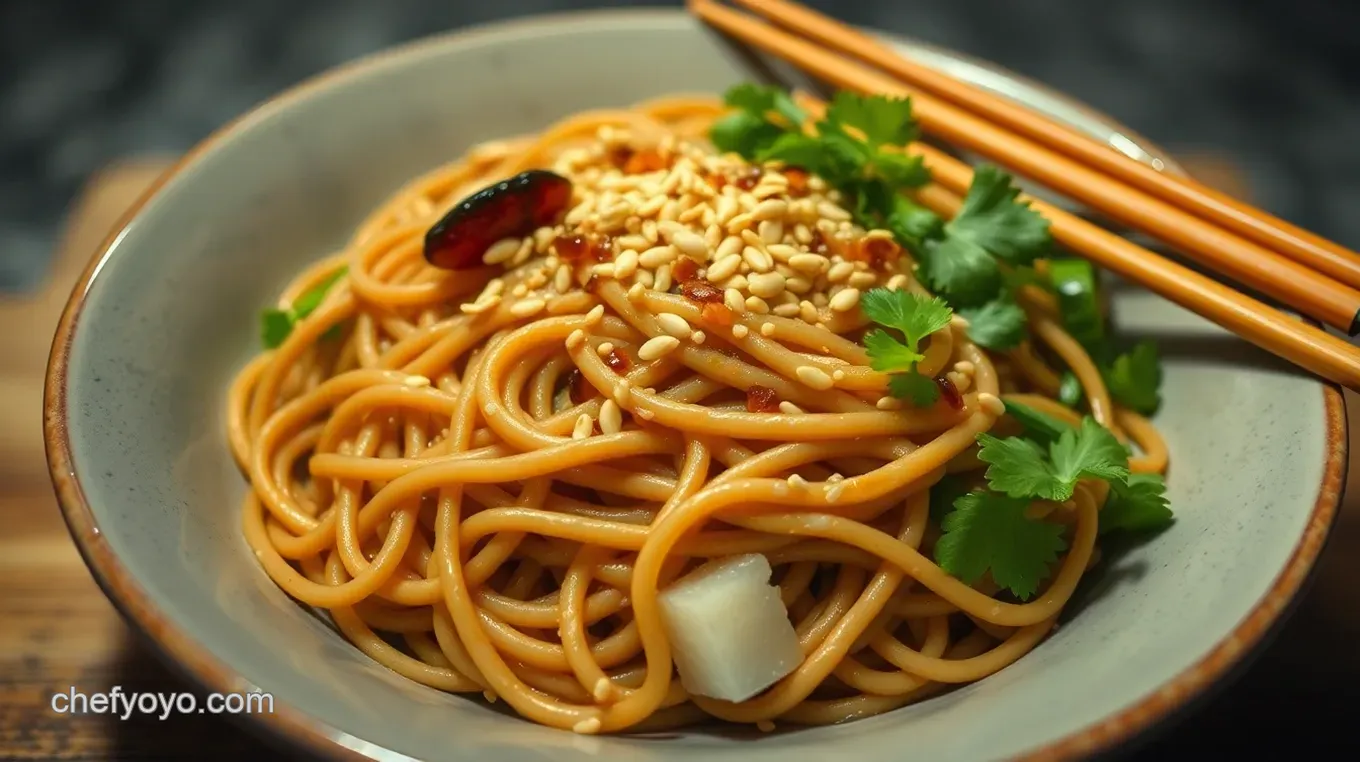
- Let’s Talk About This Awesome Soba Noodles Recipe
- Essential Ingredients Guide for Your Next Soba Noodles Recipe Adventure
- Mastering the Professional Cooking Method for Your Perfect Soba Noodles Recipe
- Extra Dish Deets: Your Go-To Soba Noodles Recipe Hacks
- Wrapping It Up: Why You’ve Gotta Try This Soba Noodles Recipe
- Frequently Asked Questions
- Recipe Card
Let’s Talk About This Awesome Soba Noodles Recipe
Okay, so picture this: it’s a blistering hot summer afternoon, and i’m craving something light but still tasty for lunch.
I don’t want to turn on the oven or make a heavy meal that leaves me wiped out. that’s when i stumbled on a soba noodles recipe that completely changed my lunch game.
Honestly, one bite and i was hooked — that cool, nutty flavor from the buckwheat noodles paired with tangy dressing was chef’s kiss perfection.
This dish is a winner every time i need something fresh, fast, and just plain yummy.
If you’re thinking, “what’s up with soba noodles anyway?” — you’re in the right spot. soba noodles are super popular in asian noodle cooking, especially japanese cuisine.
Made mostly from buckwheat noodles , they have this earthy, slightly nutty taste that’s unlike your usual pasta. oh, and heads up, for those of you on the gluten-free train, you can totally find or make a gluten free soba noodle recipe , which is a lifesaver.
Plus, it works wonders for a soba meal prep situation because it’s quick to make and even better the next day.
A Quick History Chat About Soba Noodles
So, a bit of nerdy food history: soba noodles have been a staple in japan for centuries. they originated in the edo period and were loved not just for their taste but their nutrition.
Buckwheat is packed with protein and fiber, making soba noodles a healthier option than your typical wheat noodles. today, soba has exploded in global popularity — i mean, people are making everything from garlic soba noodles to prawn soba noodles , and even cold versions with dipping sauces (hello, cold soba noodle recipe dipping sauces !).
What’s cool is that soba noodles are versatile — whether you want to whip up a hot bowl like yaki soba or mix in some seafood like shrimp and soba noodles or shrimp soba noodle recipe variants.
It’s approachable for beginners and advanced cooks alike. honestly, it takes about 20- 25 minutes to get from zero to yum on this recipe, with minimal fuss — pretty sweet when you’re starving but don’t want to stress.
Why You’ll Love This Soba Noodles Recipe
Here’s the real talk: soba noodles aren’t just tasty, they come with some solid perks. first off, buckwheat is gluten-free and loaded with antioxidants.
That means better digestion, heart health, and a good energy boost without the crash. if you’re someone who’s always hunting for nutritious meals without sacrificing flavor, this recipe should be on your radar.
Another bonus? it’s insanely easy to customize. want to turn it into a hearty meal? toss in some sautéed shrimp or maybe shrimps with noodles for a protein punch.
More veggies? no problem — sliced cucumbers or shredded carrots fit right in, making it vibrant and fresh.
Plus, this dish rocks for lots of special occasions. need a light but impressive dish for a summer bbq or a chill weeknight dinner? soba noodles have got you.
They’re also fantastic if you’re meal prepping because unlike some pasta dishes, soba holds up well in the fridge without getting mushy.
Compared to other noodle recipes, soba stands out because of its unique nutty flavor and texture. it’s a nice break from your usual spaghetti or ramen and feels a little fancy without being complicated.
Oh, and if you’re a fan of channels like a couple cooks, they often praise soba for those very reasons: simplicity, taste, and health.
What’s Next?
Now that you’re all hyped about soba noodles and why they deserve a spot in your cooking lineup, the fun part begins.
I’m about to share all the ingredients you’ll need for this chilled sesame soba noodles with soy-ginger dressing recipe. trust me, it’s as easy as it sounds — and soon enough, you’ll be slurping up a bowl that’s nutritious, flavorful, and perfect for just about any day.
Ready to dive in? Let’s see what goes into making this delicious soba meal magic happen!
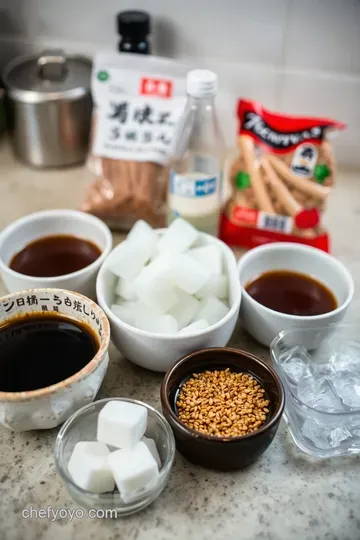
Essential Ingredients Guide for Your Next Soba Noodles Recipe Adventure
Alright, so you’re diving into a soba noodles recipe —maybe a classic shrimp soba noodles or a zingy garlic soba noodles dish? you’re gonna want to nail the ingredients first.
Honestly, i learned this the hard way: once, i grabbed some sad-looking noodles and weird soy sauce, and the whole meal felt off.
Don’t let that happen to you! let’s break down the essentials so your soba meal prep feels like a breeze, not a battle.
Premium Core Components: The Real MVPs of Your Dish
First things first, the soba noodles. look for 7 oz (200 g) dried soba noodles , ideally 100% buckwheat if you want that authentic, nutty flavor.
Some brands mix in wheat flour, which is fine, but pure buckwheat noodles are where it’s at for that signature taste.
When measuring, use a kitchen scale or measuring cups—it helps keep consistency, especially if you’re making a bigger batch. pro tip: boil noodles for 4- 6 minutes , then rinse immediately in cold water to stop overcooking.
Trust me, overcooked noodles are sad noodles.
For storage, keep the dried soba noodles in a cool, dry place , away from moisture. they usually last up to a year unopened—but once opened, try to use them within a few months for best taste.
Now, for freshness: check the packaging date and avoid noodles with a stale smell. same goes for your soy sauce and oils—freshness matters! for soy sauce, that bottle in your fridge door? yeah, it might last forever, but its flavor dims over time.
Swap out for a fresh bottle every few months.
Signature Seasoning Blend: The Heartbeat of Flavor
No soba dish is complete without a killer dressing. a soy-ginger dressing is classic. picture this: 3 tbsp soy sauce , 1 tbsp rice vinegar , 1 tbsp toasted sesame oil , a tsp of fresh ginger, honey, and garlic.
The balance of salty, tangy, nutty, sweet, and aromatic flavors hits your taste buds like a subtle flavor bomb.
Picking the right herbs? Scallions are your safe bet. They add freshness and snap. Sometimes I throw in thin nori strips or shredded carrots for color and crunch.
Regional funkiness comes from the dressing. wanna mix it up? try adding a bit of chili flakes or swapping sesame oil for peanut oil.
When i made a quick shrimp soba noodles a while back, a splash of yuzu juice gave it that zippy japanese flair—highly recommend.
Smart Substitutions: Because Life Happens
Not all of us have perfect pantries or can keep buckwheat noodles on hand all the time. no worries! if you’re after a gluten free soba noodle recipe , snag 100% buckwheat noodles—they usually fit the bill.
Otherwise, swap for rice noodles or even whole wheat pasta if you’re in a pinch.
Honey missing? maple syrup does the trick and keeps things vegan-friendly. low on soy sauce? tamari is your gluten-free friend, and coconut aminos bring a lighter, sweeter twist.
I once had to swap shrimp for shredded cooked chicken during a surprise dinner—turns out, that worked surprisingly well for a hearty take on shrimp and soba noodles .
Seasonal alternatives? Toss in fresh herbs like cilantro or mint during summer for refreshing notes. In winter, dried herbs or a pinch of smoked paprika can cozy things right up.
Kitchen Equipment Essentials: Your Sobatastic Toolkit
Alright, screw fancy gadgets. you just need a large pot to boil the noodles , a strainer or colander, and a small bowl for your dressing.
A whisk is handy but a fork works just fine for mixing that soy-ginger mixture.
If you’re like me and lack a proper measuring scale, measuring cups and spoons will keep you in check. keep a large mixing bowl ready for tossing noodles with dressing —trust me, no one wants to mix this in a tiny bowl.
Storage-wise, glass containers with tight lids are the way to go for leftovers (hello, soba meal prep convenience). and pro tip: toss chilled noodles with a tiny drizzle of sesame oil before storing to prevent clumping.
So here’s the thing—i always say, getting these details right makes your entire yaki soba or cold soba adventures sing.
Whether you’re whipping up a quick shrimp soba noodle recipe or trying those buckwheat noodle recipes that a couple cooks rave about, starting strong with the right ingredients and tools is half the battle won.
Up next, I’ll walk you through the easy step-by-step instructions so you can get cooking without a hitch. Stay tuned—this is where the fun REALLY begins!
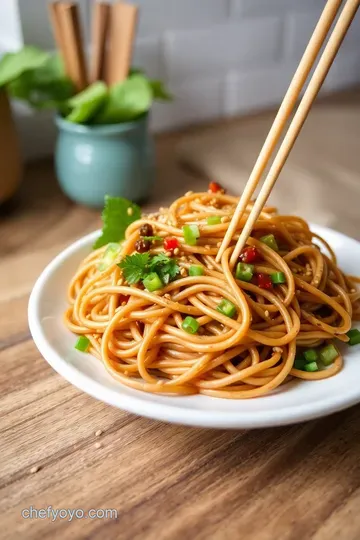
Mastering the Professional Cooking Method for Your Perfect Soba Noodles Recipe
Alright, so you wanna nail this soba noodles recipe like you’re cooking at a legit japanese joint? i’ve been there—trying to get those delicate buckwheat noodles just right without turning them into a mushy mess.
Let me walk you through some pro tips and tricks i’ve picked up along the way, from prep to plating.
Trust me, it’s all about the prep and timing.
Essential Prep Moves That Save Your Bacon
First off, let’s talk mise en place — aka everything in its place before you cook. when making dishes like garlic soba noodles or adding tasty touches like shrimp, having all ingredients chopped, measured, and ready prevents that frantic, last-minute scramble.
I always prep my sliced scallions, minced garlic, and toasted sesame seeds upfront. also, keeping your ice water ready for chilling noodles is a game changer.
You’ll want that bowl filled and prepped before the noodles hit the pot.
Time management? don’t just eyeball it. soba noodles cook fast— about 4 to 6 minutes —and you need to be precise.
Start your dressing while the noodles boil. that way, the meal prep feels smooth and you’re not washing 3 pans while things boil over.
Organization is your bff. keep your pots, bowls, and utensils laid out so you don’t drop that precious soy-ginger dressing all over the counter.
I usually clear at least a 3-foot space for my work zone. oh, and safety!! when boiling noodles, keep handles turned inward and use potholders because i’ve burned my hand way too many times grabbing a pot mid-cook.
Hot water is no joke!
Step-by-Step Guide: Making It Like a Pro
- Bring a large pot of water to a rolling boil ( 212° F). No salt needed here; soba noodles don’t want salty water.
- Add your soba noodles and gently stir so they don’t stick. Keep boiling for exactly 4– 6 minutes —this is the sweet spot for that perfect al dente bite.
- Taste a noodle! It should be tender but with a nice chew—sometimes they get super soft too fast, so watch it.
- Drain the noodles and immediately rinse under cold water until it runs clear. Then, dunk those babies in a bowl of ice water for 5 minutes. This stops cooking and keeps the texture on point.
- Drain well again and toss with your ginger-soy dressing, scallions, and sesame seeds. That’s it! Ready to eat or chill for later.
Pro Techniques That Up Your Noodle Game
Here’s a little secret from my recent attempt at the shrimp soba noodles : always toast your sesame seeds fresh.
The aroma is insane and makes a noticeable difference. another critical step is the ice water rinse . if you skip this, you’ll get clumpy, gummy noodles—gross!
Temperature control is everything. If your noodles are too hot when you dress them, the sauce warms up and loses that fresh zing. Cold soba noodles with a punchy soy-ginger dressing? Dreamy.
Quality checkpoints? noodles should never look limp or sticky. if they are, cool them longer or rinse better. dressing should be balanced—salty, tangy, with a hint of sweet and that garlicky kick.
Adjust it while mixing; everyone’s taste buds differ.
Troubleshooting — Oh man, remember the first time I didn’t chill my noodles? They turned into this noodle clump hell, and I had to start over. Lesson: never skip that ice bath!
Winning Strategies to Guarantee Success
One common screw-up I’ve seen (and made!) is overcooking the noodles. They get mushy and soak up the dressing like a sponge. Stick to the 4- 6 minutes , no more.
Another tip: if you want GF options, swap soy sauce for tamari, and you’re good to go. This way, anyone can enjoy this gluten-free soba noodle recipe without a hitch.
Make-ahead? oh yes. this dish actually tastes better when the flavors meld for an hour or two in the fridge.
Perfect for soba meal prep lunches. just keep the garnishes separate so they don’t get soggy.
For perfect results, always rinse noodles until water runs clear and chill well. The difference between soggy and crisp noodles is literally night and day.
If you’re curious about dipping sauces for a cold soba noodle recipe dipping sauces setup or want to mix things up with prawn soba noodles or even a stellar yaki soba stir-fry, stay tuned! i’m gonna share some killer extras in the next section with more tasty insights and creative ideas.
Trust me, once you get these professional cooking moves down, whipping up dishes like shrimp and soba noodles or shrimps with noodles will be a quick, chill, and seriously delicious routine.
Oh, and by the way, this isn’t just for pros—you can totally do this at home, no fancy gear needed!
Next up: Additional Information where I’ll spill more on sauces, variations, and handy tips to elevate your soba noodle game even more. Stick around!
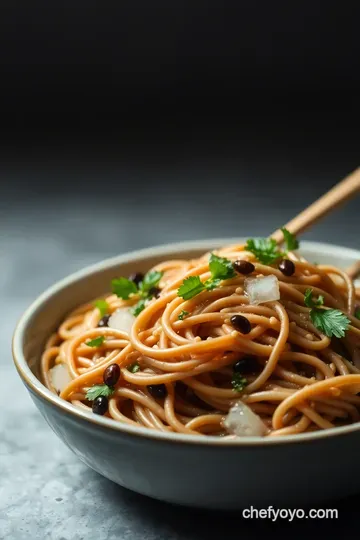
Extra Dish Deets: Your Go-To Soba Noodles Recipe Hacks
Alright, so if you’re diving into this soba noodles recipe — especially that chilled sesame style — you’ve gotta know some pro tricks to level things up.
Honestly, i learned these the hard way, burning noodles, bland bites, you name it. but hey, trial and error makes food tales way more fun, right?
Pro Tips & Secrets: What the Chef Won’t Always Tell Ya
First off, don’t salt the water when boiling your buckwheat noodles — sounds weird, but trust me, soba likes it plain.
Stir them gently near the start to keep the noodles from turning into a sticky mess. nobody wants a clumpy noodle nightmare!
Rinsing those noodles really well after boiling? super important. i’ve been lazy on this step and ended up with gummy noodles.
Rinse under cold water till the water runs clear — extra starch is the enemy here.
Want that sweet toasted sesame kick? Toast your own seeds in a dry pan for a couple of minutes. The store-bought ones just can’t compete with the fresh flavor burst.
Oh, and if you want to save some time during a busy week, make a double batch for soba meal prep .
Chill and keep in the fridge for up to 3 days. it’s way easier to whip up quick lunches — especially if you toss in easy proteins like shrimp or tofu.
Perfect Presentation: Make It Look As Good As It Tastes
I’m all about eating with my eyes first. for this shrimp soba noodles plate, i’ve found that layering colors and textures really makes it pop.
Think bright green scallions and a sprinkle of orange shredded carrots. plus, that black edge of nori strips adds a fancy touch without trying too hard.
A neat tip? when plating, twirl a small bundle of noodles around your fork or chopsticks, place it in the center, and let the garnishes surround it like little edible confetti.
Keeps that “restaurant vibe” without stealing hours from your dinner prep!
Storage & Make-Ahead: Keep It Fresh & Ready to Rock
I’ll admit — reheating soba noodles can be a bit tricky. if you want to enjoy leftovers, store your noodles and dressing separately.
To reheat, just dip the noodles briefly in hot water to warm ‘em without turning mushy. then toss with fresh dressing or your cold soba noodle recipe dipping sauces like a spicy sesame or citrus soy.
Noodles are best eaten within 2-3 days stored in airtight containers. Beyond that, they start losing that fresh, chewy bite we ALL love in your classic shrimp and soba noodles bowl.
Creative Twists: Make This Dish Your Own
If you’re craving variety, here’s where you can really have fun. Swap out the usual soy sauce for tamari if you’re hunting for a gluten free soba noodle recipe .
Or, throw in some garlic for a punchier version — hello, garlic soba noodles ! when the weather cools down, try simmering your noodles in a broth for a cozy hot spin — think yaki soba vibes but with a homemade twist.
For that extra wow factor, add some cooked prawns or shrimps — honestly, I’m obsessed with the prawn soba noodles version. Shrimp’s sweet seafood flavor complements the nutty buckwheat noodles so perfectly.
Nutrition Cheat Sheet: What You’re Really Eating
Here’s the scoop: soba noodles are made from buckwheat, so they’ve got a surprisingly good protein and fiber count, which makes this dish filling without feeling heavy.
If you’re watching calories (who isn’t these days?), this recipe clocks in at around 280-ish per serving — pretty solid for a main meal.
Plus, it delivers a nice dose of manganese, magnesium, and antioxidants thanks to buckwheat.
Keep an eye on sodium though, especially if you load up the soy sauce. swap in low-sodium versions or dilute with more vinegar or citrus juice for zesty punch without the salt overload.
Portion-wise, a bowl like this keeps things balanced between carbs, fats, and protein — especially when paired with shrimp or chicken.
Wrapping It Up: Why You’ve Gotta Try This Soba Noodles Recipe
Honestly, this dish has been my summer go-to for years. it’s light, packed with flavor, and that chewy, nutty bite of buckwheat noodles ? chef’s kiss.
Whether you’re after a quick lunch, a healthy dinner, or craving a refreshing meal that won’t weigh you down, this one’s a keeper.
So next time you’re thinking, “what’s quick, tasty, and a little different?” — give this shrimp soba noodle recipe a shot.
Trust me, once you master chilling and dressing those noodles, you’ll wanna make it all year round. plus, you get bragging rights with your friends for rocking an authentic asian noodle dish that’s easy and impressive.
Go on, give your kitchen a little Tokyo twist today!
Frequently Asked Questions
What’s the easiest way to cook soba noodles properly?
For a perfect soba noodles recipe, boil the noodles in plenty of water without adding salt. Cook them just until al dente (usually 4–6 minutes), then rinse immediately under cold running water to remove starch and stop the cooking. Finally, chill them in ice water for a chewy, refreshing texture—this step is key to avoid mushy noodles.
Can I eat soba noodles hot, or are they only served cold?
While this soba noodles recipe shines as a chilled dish, especially during warmer months, soba noodles are traditionally enjoyed both hot and cold. For a warming meal, simply serve freshly boiled noodles with a hot broth or dipping sauce. Cold soba, however, offers a refreshing bite and is particularly popular in Japanese summer dining.
What’s the best way to store leftover soba noodles or the prepared dish?
Store leftover cooked soba noodles in an airtight container in the fridge for up to 2 days. Keep the noodles and dressing separate if possible to prevent sogginess. When you're ready to eat, toss them together again and enjoy cold or at room temperature for best texture and flavour.
Are soba noodles gluten-free, and are there any substitutions for gluten-sensitive eaters?
Traditional soba noodles are made primarily from buckwheat, which is gluten-free, but many brands mix in wheat flour. If you’re gluten-sensitive, look for 100% buckwheat noodles labeled gluten-free, or substitute with gluten-free whole grain noodles or rice noodles. Also, swapping soy sauce for tamari or coconut aminos ensures the dish remains gluten-free.
How can I add some extra protein or veggies to this soba noodles recipe without losing its authentic flavour?
Adding shredded cooked chicken, tofu, or edamame beans boosts protein without overpowering the classic soy-ginger dressing. For veggies, thin cucumber slices, shredded carrot, or scallions complement the nutty buckwheat. These simple additions maintain the clean, refreshing vibe of the dish while making it more filling.
Any tips to make the dressing pop with authentic Japanese flavours?
Use freshly grated ginger and toast your sesame seeds for a richer aroma. Adjust the balance by adding a bit more rice vinegar for tang or a pinch of chili flakes for heat. Swapping honey for maple syrup keeps it vegan-friendly but still adds that gentle sweetness balancing the salty soy sauce perfectly.
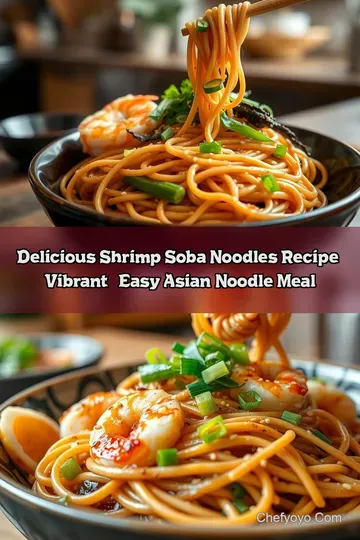
Chilled Sesame Soba Noodles with Soy-Ginger Dressing Card

⚖️ Ingredients:
- 7 oz (200 g) dried soba noodles (100% buckwheat if possible)
- Water for boiling
- Ice cubes (for chilling noodles)
- 3 tbsp soy sauce (or tamari for gluten-free)
- 1 tbsp rice vinegar
- 1 tbsp toasted sesame oil
- 1 tsp freshly grated ginger
- 1 tsp honey or maple syrup
- 1 small garlic clove, minced
- 2 scallions, thinly sliced
- 1 tbsp toasted sesame seeds
- Optional: thin strips of nori (seaweed) or shredded carrot
🥄 Instructions:
- Step 1: Bring a large pot of water to a boil without adding salt, then add the soba noodles and cook according to package instructions, typically 4-6 minutes, stirring occasionally.
- Step 2: Drain the noodles in a colander, rinse under cold water to stop cooking and remove excess starch, then submerge in a bowl of ice water for a few minutes.
- Step 3: In a small bowl, whisk together soy sauce, rice vinegar, toasted sesame oil, grated ginger, honey, and minced garlic to prepare the dressing.
- Step 4: Place the chilled noodles in a large bowl, pour the dressing over them, and toss gently until evenly coated.
- Step 5: Sprinkle sliced scallions and toasted sesame seeds over the noodles. Optionally, garnish with nori strips or shredded carrot. Serve immediately or chilled.
Previous Recipe: Easy Classic Apple Crisp Recipe Easy – My Cozy Autumn Family Favourite
Next Recipe: Hearty No Bean Chili Recipe: My Easy, Protein-Packed Classic
